Abstract
Most of the onshore water-flooding oilfield reservoirs have dominant seepage channels dominated by large pores and fractures, resulting in the oilfield being in a period of high water cut. The treatment of this problem needs to be solved by plugging. In the research process, the particle size and suspension of the water-swellable rubber particles were measured, and the effective time of the particles was evaluated; matching relationship. The results show that adding 2000 mg/L polymer to the water-swellable rubber particles can better improve the suspension performance; the performance of the polymer solution will not be affected during mixing and injection. In addition to strong swelling performance, it also has a certain strength and deformability, up to 10 MPa high via pressure and good thermal stability. Compared with the water and oil environment, the chemical degradation phenomenon is significant after soaking in alkaline conditions. Compared with the alkaline environment and the formation water environment, the final expansion ratio of the water-swellable rubber particles in the formation oil environment is as low as 2.5 times, which has the ability to block water. There was no oil blocking feature. When the crack width is too small, particles with excessively large particle sizes may accumulate at the injection end of the core, resulting in failure to inject into the core and fail to achieve the plugging effect. For the treatment of large, fractured pores, it is possible to first inject particles with a particle size of 0.250–0.420 mm to block areas with high permeability, and then inject particles with a particle size of 0.150–0.250 mm to block areas with low permeability.
1. Introduction
At present, most of the onshore oilfields use water flooding to supplement the formation energy, which improves the degree of recovery to a certain extent. After long-term water flooding development, dominant seepage channels dominated by large pores and fractures have been formed. In recent years, after long-term liquid flow scouring in the area near the wellbore of the onshore oilfield injection wells led by the Daqing Oilfield, the formation clay minerals and solid particles stripped and migrated under the action of the liquid flow, which led to a further increase in the formation permeability near the natural fractures. Increased formation of high-permeability strips at local locations, intensified conflicts between layers and within layers, and the problem of dominant channels are more prominent []. At present, the method of plugging high-permeability channels is mainly used to realize the treatment of dominant channels. The commonly used methods include polymer flooding technology, local profile control and plugging technology, and cement sealing and channeling technology applied to the entire interval []. Lu Yonghui [] and others added polyhydric phenol enhancer to the cross-linking system of modified polyacrylamide and oligophenolic aldehyde, and developed a new type of gel system, which not only has a short gel-forming time, but also is stable and stable. It has excellent properties and shear resistance, is easy to squeeze into the deep reservoir, and can effectively improve the water absorption profile. Zhang Miaoxin [] et al. prepared a weak gel suitable for high temperature resistance and deep profile control with chromium chloride hexahydrate and partially hydrolyzed polyacrylamide. The gel system, with strong fluidity, strong gel-forming ability, and adjustable molecular configuration, has a relatively strong blocking ability for medium and high permeability layers. Sun Ning [] prepared a new type of weak gel system by hydrophobically associating polymer AP-P4 and chromium acetate. The system has both viscoelasticity, excellent salt resistance, temperature resistance and shear resistance, and can be used in rock. Migration occurs in the heart, and it has a relatively strong sealing ability for medium and high permeability layers.
At present, there are many types of gel-type profile control agents which can effectively use the residual polymer in the formation to form a grid-like gel to plug the pores and enter the smaller pores that the particle-type profile control agent cannot enter to achieve plugging. The overall cost of some profile control agents is high, and some even have certain toxicity. Considering the economic cost and environmental protection, although this kind of profile control agent is effective, a large amount of injection cannot achieve the goal of low cost [,,]; most of them have a short validity period, poor plugging effect, and cannot achieve long-term plugging of fractured pores [].
The research shows that the agent rubber particles have the advantages of good expansion performance and low price. The disadvantage is that the particle size of the particle-type profile control agent is larger, and the sealing performance of large and medium-sized channels is good, but the small channels and fractures cannot pass the migration effect. However, the blocking performance is poor [,], so it is necessary to improve the traditional rubber particles to solve the problem of the existence of such blocking agents. Among them, water-swellable rubber particles are one of the better choices [].
Generally, water-swellable rubber particles are synthesized by chemical grafting, etc. The chemical grafting method is mainly used in the preparation of grafted polar chains or rubber itself on hydrophobic polymers such as polyolefins []. For the rubber matrix, the mechanical properties of the main material should be considered [], so in the preparation process of water-swellable rubber, rubber with high polarity, good adhesion, and good elasticity, nitrile butadiene, is generally selected. Rubber, natural rubber [], etc., and nitrile rubber can be synthesized by the emulsion hydrogenation method [] to synthesize hydrogenated nitrile rubber. Wang Boxiang [] and others used sodium bisulfite/potassium persulfate as initiators to prepare water-swellable rubber by grafting reaction. Compared with the water-swellable rubber prepared by physical blending, the water-swellable rubber prepared in this way has a higher expansion ratio, and at the same time alleviates the disadvantage of the precipitation of hydrophilic molecules. Zhou Xiaoyan et al. [] prepared a water-swellable rubber that can still maintain performance in 200,000 high-concentration salt water. This water-swellable rubber has better salt resistance.
In this paper, a new type of water-swelling rubber particle system is developed through the research literature, and the synthesis and plugging mechanism of the fractured pore plugging system in high water-cut reservoirs are carried out by using this system. While ensuring the plugging performance, it achieves the effect of cost reduction, a “pluggable and sparse” oil layer, and the effect of selectively plugging high water cut areas, laying a foundation for further reducing permeability in the later stage, and for the later stage of high water cut reservoirs. This is of great significance to efficiently develop and further improve oil recovery.
2. Materials and Methods
2.1. Experimental Materials
First, synthetic rubber is prepared and modified. The properties of rubber particles are shown in Table 1.

Table 1.
Physical and chemical properties of rubber particles.
Materials in the synthesis process: butadiene rubber, Shanghai Haiyu Chemical Co., Ltd., Shanghai, China, sodium hydride, Xiongda Chemical, Dongguan, China, cycloethane, Jindong Tianzheng Fine Chemical Reagent Factory, Tianjin, China; filler: calcium powder (CaCO3), Huaxin Chemical Co., Ltd., Xuancheng, China, carbon black, Dehui Environmental Technology Co., Ltd., Qingdao, China, phenolic resin (C7H6O2), Sanshi Biotechnology Co., Ltd., Jining, China, starch (C6H12O6), Zhenfang Trading Co., Ltd., Xingtai, China, Sulfur, Yinsong Chemical Co., Ltd., Yulin, China, etc.
Instruments during the experiment: high pressure reactor, Teer Instrument Equipment Co., Ltd., Zhengzhou, China, slow internal mixer, Yingbei Machinery Equipment Factory, Shanghai, China, calender, Yikuang Machinery Equipment Co., Ltd., Shandong, China, die-casting machine, Anxin Intelligent Technology Co., Ltd., Dongguan, China, interfacial tension tester, Insa Instrument Technology Co., Ltd., Dongguan, China, particle parameter analyzer, Juchuang Environmental Protection Group Co., Ltd., Qingdao, China, hydraulic press, Da Wei Machine Tool Co., Ltd., Nantong, China, core holders, constant pressure constant speed pumps, electronic balances, pressure testing equipment, etc.
2.2. Synthesis and Separation of Water Swelling Rubber
The synthesis principle of water swelling rubber is shown in Figure 1. The anionic active center is generated by chemical reaction on the polymer chain of ordinary rubber, and then hydrophilic monomer is added to initiate growth at the anionic active point, so as to improve the hydrophilicity of ordinary rubber performance.
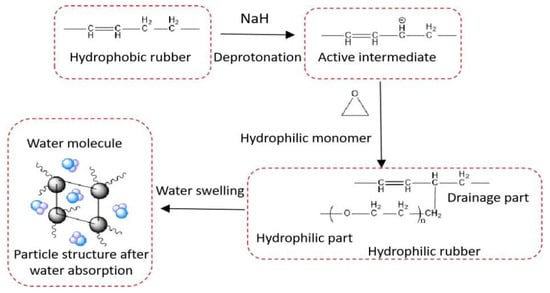
Figure 1.
Synthetic reaction principle and expansion diagram of water swellable rubber.
The synthesis steps of modified water swelling rubber are as follows:
- (1)
- Synthetic rubber particles
Add 15% sodium hydride solution into the rubber powder of cis-1,4-polybutadiene rubber, and fully stir for 1 h. Add 20% cyclohexane into the liquid after reaction in the high-pressure reactor, and then fully stir for reaction for 2 h. After obtaining rubber particles, dehydration and filtration are carried out.
- (2)
- Modification of rubber particles
Plasticizing the synthetic rubber at 150 °C with an internal mixer for about 3–5 min; keeping the temperature at 130 °C in the slow-speed internal mixer, adding synthetic rubber, calcium powder, carbon black, phenolic resin, starch, and other materials in turn. Mixing in the apparatus and cooling to 80 °C. Adding sulphur to the machine. Turning all the materials on a heat mill, and making films on a calender, keeping the body temperature at 55 °C, the head at 75 °C, and the mouth at 85 °C. When the temperature is 85 °C, the rubber compound is placed in the plug cylinder of the die-casting machine, and the rubber compound is cast into the mold cavity for vulcanization under pressure, and water-swellable rubber is obtained after vulcanization for 30 min. The water-swellable rubber is pulverized into particles with a pulverizer.
- (3)
- Separation of modified water swelling rubber particles
After the water swelling rubber particles are crushed, in order to distinguish the rubber particles with different particle sizes, the rubber particles with different particle sizes are sorted, as shown in Figure 2.
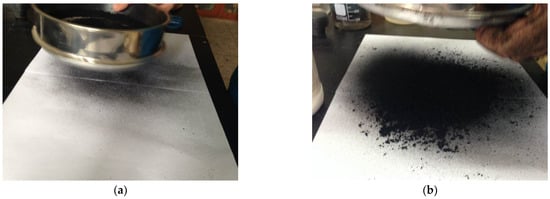
Figure 2.
Particle screening. (a) Primary screening particles, (b) Particle after sieve.
Take the number of standard sieve mesh between 20 and 100, and stack the sieve mesh according to the aperture size. Put the water swelling rubber particles on the 20 mesh screen and cover the screen cover. Place the screen mesh on the screen shaker, clamp and vibrate for 3 min. Weigh the sample that fails to pass the 20 mesh screen and the sample on the chassis, and record it as m. Calculate the particle size, expressed as the percentage of the mass between two sieves in the sample mass.
When the particle size D ≥ 50%, the mesh size of the upper and lower screens is the range of rubber particle size. When the particle size is less than 50%, replace the 20 mesh screen with a larger mesh screen until the particle size is ≥50%.
Through screening, three kinds of water swelling rubber particles with particle size range of 0.150~0.250 mm, 0.250~0.420 mm, and 0.420~0.840 mm were separated.
The modified water-swellable rubber particles are observed by scanning electron microscope, and the specific performance is shown in Figure 3.
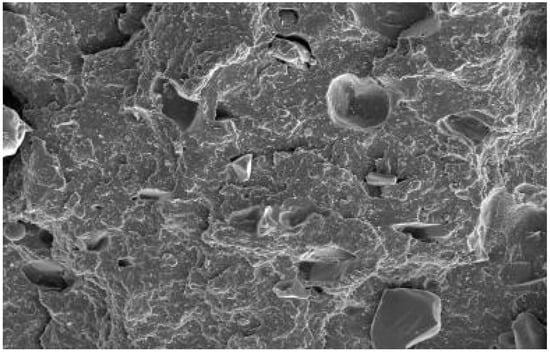
Figure 3.
Scanning electron microscope photo of modified water-swellable rubber particles.
The modified particles have a flat cross section and a large flat area, and phenolic resin particles can be seen, indicating that the phenolic resin has good compatibility with synthetic rubber and has the ability to absorb water and expand.
2.3. Determination of Basic Properties of Water Swelling Rubber Particles
- (1)
- Determination of density of water swelling rubber particles
Too large or too small rubber particle density is not conducive to entering the deep formation for profile control, so it is necessary to measure the particle density.
Add anhydrous kerosene to the neck of the density bottle, cover the bottle stopper, place it in a constant temperature bath for 20 min, and then read the liquid level scale V0. Use an electronic balance to weigh a certain amount of water swelling rubber particles into the density bottle, shake gently to drain the bubbles in the bottle, cover the bottle stopper, and read the liquid level scale Vi in the same way to calculate the density of water swelling rubber particles.
- (2)
- Determination of particle suspension of water swelling rubber
When the water-swellable rubber particles are put into the solution, they will be dispersed in the solution and suspended in the solution by buoyancy and other effects. To assess whether it can enter the deep formation, it is necessary to measure the suspension of water-swellable rubber in polymer solution under different particle sizes and different concentrations.
(1) Determination of suspension properties of water swelling rubber particles with different particle sizes in polymer solution
On the premise that the concentrations are 500 mg/L, 1000 mg/L, 2000 mg/L, 3000 mg/L, 4000 mg/L and 5000 mg/L, respectively, add three kinds of water swelling rubber particle solutions into the 500 mg/L polymer solution and stir at a constant speed for about 1 min. After the solution is still, record the settling time of multiple particles.
(2) Evaluation of suspension properties of water swelling rubber particles in polymer solutions at different concentrations
Add three kinds of water swelling rubber particle solutions with concentration of 3000 mg/L into the polymer solutions of 500 mg/L, 1000 mg/L, 2000 mg/L, 3000 mg/L, 4000 mg/L and 5000 mg/L respectively, and stir at a constant speed for about 1 min. After the solution is kept still, record the settling time of multiple particles.
(3) Determination of suspension rate of water swelling rubber particles
Simulated formation water and polymer solution are used to prepare suspension. Water swelling rubber particles with concentration of 3000 mg/L and particle size of 0.250–0.420 mm are selected to be added into formation water and polymer solution with concentration of 2000 mg/L. After standing in a measuring cylinder for a period of time, the mass of effective components in one tenth of the bottom suspension is measured, and the suspension rate is calculated.
- (3)
- Effect of water swelling rubber particles on properties of polymer solution
In order to avoid the influence of water swelling rubber particles on the properties of polymer solution, the interfacial tension was measured in the laboratory for verification. The concentration of polymer solution is set as 2000 mg/L. Weigh 3000 mg/L water swelling rubber particles into the polymer solution, put them into a 45 °C thermostat, and measure the viscosity and interfacial tension of the polymer solution with water swelling rubber particles and the blank control sample without particles at 3 days, 10 days, and 15 days respectively.
- (4)
- Effect of clean water and sewage on swelling property of water swelling rubber particles
Select the water swelling rubber particles with the particle size of 0.250–0.420 mm, measure the particle volume with a density bottle, prepare water polymer solution and sewage polymer solution, soak the particles in the two systems respectively, take out the particles every other period of time for volume measurement, and calculate the particle expansion multiple at different times.
- (5)
- Evaluation of compressive strength of water swelling rubber particles
The modified water swelling rubber particles not only have the characteristics of high strength of ordinary rubber particles, but also have certain deformation properties, which can not only enter the high permeability area through deformation and crushing, but also ensure the plugging performance of the particles. The compressive strength of rubber particles is used to evaluate their strength and deformation, which is usually measured by the pore pressure test method. The specific experimental steps are as follows:
Weigh 5 g of particles of three sizes respectively, put the particles into 250 mL measuring cylinders with plugs, add 200 mL of 2000 mg/L polymer solution into the vector cylinders, cover the plugs, and place them in the 45 °C incubator for 24 h until the expansion times of particles are relatively stable. Take the expanded particles and put them into the particle parameter tester and select the eyelet Φ 0.3 mm orifice plate. Use the automatic constant speed constant pressure pump to pressurize the device at the injection rate of 10 mL/min, use the average value of the breakthrough pressure curve of the orifice plate as the breakthrough pressure of the orifice, and record the pressure value.
- (6)
- Evaluation of thermal stability of water swelling rubber particles.
The possibility of reducing the compressive strength of water swelling rubber particles due to the influence of formation temperature was studied. Select the water swelling rubber particles with the intermediate particle size of 0.250–0.420 mm, place them in the simulated formation water solution, put the particles into the thermostatic box with the temperature of 40 °C, 60 °C, 80 °C, and 90 °C, take them out after expansion for 90 days. Measure the compressive strength of the particles, and determine the thermal stability of the rubber particles.
2.4. Effective Action Time of Rubber Particles
For profile control agents acting on deep reservoirs, the particles should have degradable properties on the premise of ensuring the plugging ability of particles. By studying the stability of water swelling rubber particles in various fluid environments, and whether the particles have degradability in these fluids, the effective action time of the particles was determined.
- (1)
- Determination of degradability of water swelling rubber particles in various environments
Select the water swelling rubber particles with the intermediate particle size of 0.250–0.420 mm, put the water swelling rubber particles into the water, sewage, simulated crude oil, kerosene, diesel oil, 1.2% Na2CO3 solution, 1.2% NaHCO3 solution, and 1.2% NaOH solution, respectively, and soak them for 90 days. After soaking, take out the particles for appearance observation, as shown in Figure 4:
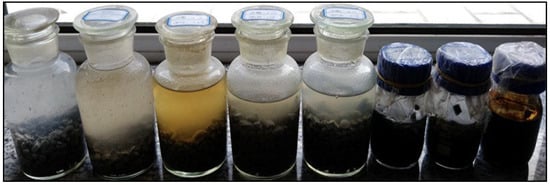
Figure 4.
Different media for soaking water-swellable rubber. From left to right, they are clean water, sewage, sodium hydroxide, sodium carbonate, sodium bicarbonate, oil production, crude oil, kerosene.
- (2)
- Determination of swelling properties of water swelling rubber particles in various environments
The environment in which the particles are located is the same as the environment in which the degradability is evaluated. At 5 days, 15 days, 30 days, 45 days, 60 days, 75 days, and 90 days, the particles are taken out to measure the size, and the expansion times of the particles at different times under different environments.
- (3)
- Determination of compressive strength of water swelling rubber particles in various environments
The environment of the particles is the same as that when evaluating the degradability. Take the water swelling rubber particles soaked for 90 days, put them into the particle parameter tester, and measure the compressive strength.
2.5. Sealing Performance of Water Swelling Rubber Particles for Large Cracks
When the water-swellable rubber particles are injected into the formation, they will gradually swell and block the high-permeability pores due to the expansion effect. The research mainly focuses on the matching relationship between particles and fracture pore throats, the plugging performance before and after particle expansion, and the erosion resistance of particles. The experimental process is shown in Figure 5:
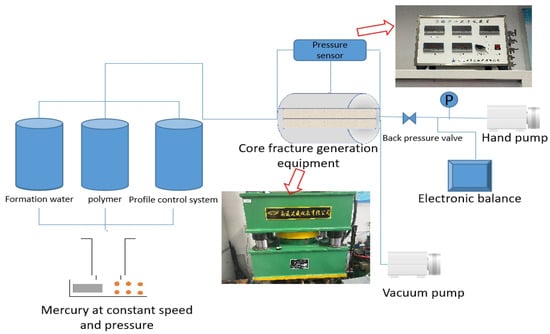
Figure 5.
Experimental flow chart.
In the experiment, two Bailey cores of the same size were put into the experimental device and pressed against each other to simulate the specific situation of fractured pores in the reservoir. The experiment selected Bailey cores with a permeability of 500 × 10−3 μm2, use a core cutting machine to adjust its specifications, cut it into two block cores with a length of 15 cm and a height of 4.5 cm, use a balance to measure the dry weight of the cut cores, and then use a vacuum pump to vacuumize the cores to saturate the formation water. The cut core is fitted into the core fracture generation equipment, it is sealed well, and the size of the crack is controlled by changing the pressure on the equipment. The experimental cores are shown in Figure 6:
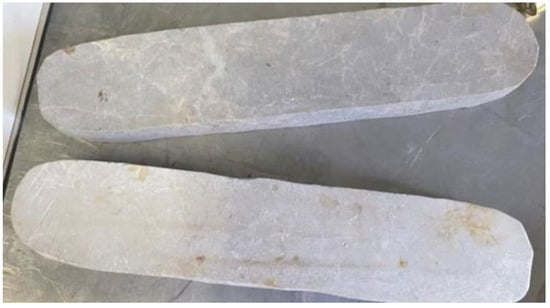
Figure 6.
Experimental core.
- (1)
- Effect of swelling of water swelling rubber particles on plugging performance
During the experiment, the pressure of the overlying core is set as 6 MPa, 8 MPa, 10 MPa, 12 MPa, and 14 MPa, and the influence of water swelling rubber particles before and after expansion on the plugging performance of fractured large pores is tested. The experimental steps are as follows:
After the experimental core is treated, use a vacuum pump to vacuum the core to saturate the formation water, and record the saturated water volume of the core; put the treated core into the core crack generation equipment and seal it, and slowly pressurize the core until the set pressure; The constant-speed and constant-pressure pump injects simulated formation water into the core at a speed of 1 mL/min until the pressure is stable, observe the specific value of the pressure sensor, and record it as P1; use the constant-speed and constant-pressure pump to inject 3000 mg into the core at a speed of 1 mL/min /L water-swellable rubber particle solution, and inject 2000 mg/L polymer solution for a total of 1 PV, observe the specific value of the pressure sensor, and record the pressure P2; use a constant speed and constant pressure pump to inject the simulated formation into the core at a speed of 1 mL/min Water 1 PV, observe the specific value of the pressure sensor, record the pressure P3; calculate the resistance coefficient and residual resistance coefficient.
The experiment was repeated by changing the overlying core pressure after recording. After soaking the water-swellable rubber particles in the formation aqueous solution for 30 d, the experiment of measuring the resistance coefficient and the residual resistance coefficient was repeated. The changes of resistance coefficient and residual resistance coefficient before and after expansion were compared under different overlying pressures.
- (2)
- Determination of plugging performance of water swelling rubber particles for large cracks
Select a particle size of 0.150–0.250 mm, and conduct plugging performance test with fracture channels of different sizes.
The operation method during the experiment is mostly the same as that of (1) in 2.5. The difference is that the volume of injected water swelling rubber particle solution and polymer solution is 0.2 PV, and the volume of injected simulated formation water into the core is 5 PV. Record the corresponding parameters and calculate the plugging rate.
- (3)
- Determination of Erosion Resistance and Matching Relationship of Water Expandable Rubber Particles to Large Crack Pores
Prepare fracture channels with different sizes, conduct erosion resistance tests on three kinds of water swelling rubber particles, and find out the matching relationship between different particle sizes and different fracture throats. The operation method of the experimental process is the same as (1) in 2.5. Besides the parameters in the first two experiments, record the parameters, including water drive stability, pressure, and pressure after injection water flushing, and observe the injection end and outlet end of the core and the fluid production. Compare the stable plugging rate with the plugging rate after simulated formation water flushing. The same operation method is used to calculate the core plugging rate under different grain sizes and different overlying core pressures.
3. Analysis of Experimental Results
3.1. Evaluation Results of Basic Properties of Water Swelling Rubber Particles
- (1)
- Determination results of particle density of water swelling rubber
The density of water swelling rubber particles is determined as shown in Table 2:

Table 2.
Particle Density.
The particle density of the modified water swelling rubber is suitable for deep profile control and meets the standard.
- (2)
- Determination results of suspension properties of water swelling rubber particles
According to the experimental process in 2.3, the suspension performance of water swelling rubber particles in 500 mg/L polymer solution is shown in Table 3:

Table 3.
Particle Suspension Data at Different Particle Concentrations.
The suspension and sedimentation state of water swelling rubber particles in polymer solution is shown in Figure 7:
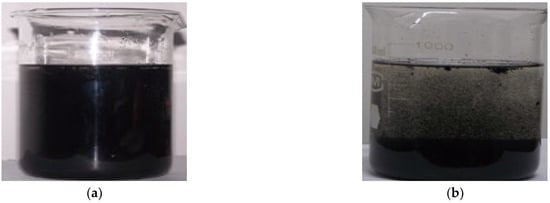
Figure 7.
The state of the particles in the polymer solution. (a) Suspended state of particles in solution, (b) Settling state of particles in solution.
It can be seen from Table 3 that in the polymer solution with a concentration of 500 mg/L, the sedimentation speed of particles with different concentrations is faster, and it is impossible to maintain the suspended state within 30 min. It is necessary to consider increasing the concentration of the polymer solution to ensure the suspension of the particles. For the consideration of settling time and economic cost, 3000 mg/L water-swelling rubber particles were initially selected for suspension performance experiments under different polymer concentrations.
Next, the suspension properties of rubber particles at different polymer concentrations are shown in Table 4:

Table 4.
Particle Suspension Data Sheet at Different Polymer Concentrations.
It can be seen from Table 4 that when the polymer concentration reaches 1000 mg/L, the settling time of particles with particle size of 0.150–0.250 mm can reach 28 min, which can meet the needs of deep profile control. The concentration of polymer solution with the particle size of 0.250–0.420 mm is 2000 mg/L, and the limit concentration of particles with the particle size of 0.420–0.840 mm is 3000 mg/L. For the treatment of fractured channels, while using water swelling rubber particles to block, it is necessary to add polymer to improve the suspension capacity of the system.
The suspension rate test results of water swelling rubber particles in formation water and polymer solution are shown in Table 5:

Table 5.
Particle Suspension Test Results in Formation Water and Polymer Solutions.
The water-swellable rubber particles are uniformly dispersed in a stirring state; after 30 min in a static state, 60% of the particles in the formation water float on the liquid surface, while 40% settle at the bottom. After the same time, 80% of the particles in the polymer solution float on the liquid surface, and 20% settle at the bottom. The suspension performance of particles in polymer solution is higher than that in formation water, and polymer needs to be added to improve the suspension capacity of the system.
By comparison, a polymer with a concentration of 2000 mg/L was selected for follow-up experiments, which not only ensures that most of the particles have good suspension properties and will not settle and accumulate near the wellbore, but that the cost will also not be too high.
- (3)
- Effect of water swelling rubber particles on properties of polymer solution
The experimental results are shown in Table 6, where 1 # is polymer solution, while 2 # and 3 # are water swelling rubber particles and polymer solution.

Table 6.
Viscosity and interfacial tension changes in particle solutions and polymer solutions.
It can be seen from the comparison that the viscosity of water swelling rubber particles placed in polymer solution and blank control sample is about 40 mPas after 15 days, and the interfacial tension is maintained at 2.5~3.3 × 10−3 mN/m. Comparing the solution with the blank control sample, the viscosity and interfacial tension of the solution did not change significantly compared with the blank control sample, indicating that the water-swellable rubber particles had no significant effect on the viscosity and interfacial tension of the polymer solution, and there would be no significant impact when the two were mixed and injected. Affect the properties of the polymer solution.
- (4)
- Effect of clean water and sewage on the swelling property of water swelling rubber particles
When water and sewage are used for liquid preparation, the expansion multiple curve of water swelling rubber particles is shown in Figure 8:
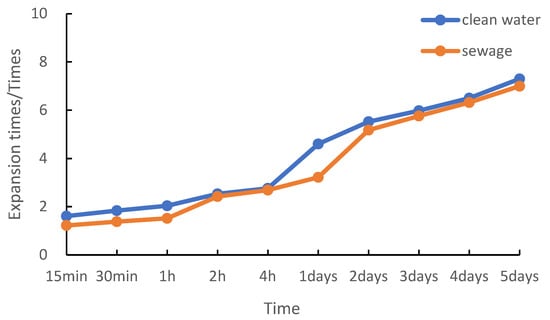
Figure 8.
Variation curve of particle expansion ratio with time.
It can be seen from Figure 8 that the water swelling rubber particles will not expand rapidly within 30 min to 4 h in clean water polymer solution and sewage polymer solution but will expand slowly with time. The expansion ratio of particles in clean water at the initial stage is slightly higher than that in sewage, but the difference between the expansion ratios of the two will gradually narrow over time, and eventually become consistent.
To sum up, the water swelling rubber particles have the characteristics of slow expansion in both clean water and sewage, indicating that the particles will not expand prematurely during the injection process, the injection performance is good, and the expansion times in sewage and clean water are almost the same, which can be directly configured into sewage polymer solution for injection.
- (5)
- Evaluation results of compressive strength of water swelling rubber particles
The pore strength of water swelling rubber particles is shown in Table 7:

Table 7.
Particle Via Pressure Data.
The expanded particles of the three particle sizes can all pass through the orifice, and the through-hole pressure increases with the increase of the particle size, but the overall difference is not significant. The expanded particles glue to each other to form a filamentous cement. The particle pore experiment is shown in Figure 9:
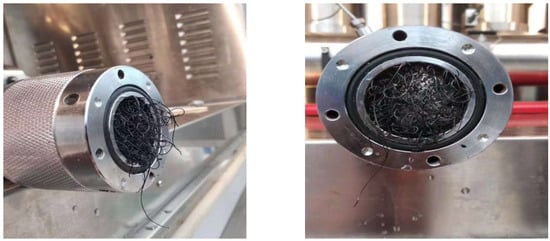
Figure 9.
Particle Via Experiment.
It can be seen that the water expanded rubber particles have not only strong expansion performance, but also certain strength and deformation. Compared with ordinary rubber particles, the pore pressure of water expanded rubber particles is controlled at a better level, so they can not only reach the high permeability area in the formation through deformation and crushing for plugging, but also have a large breakthrough pressure after plugging. A strong sealing effect can still be maintained in the fractures.
- (6)
- Evaluation results of thermal stability of water swelling rubber particles
The compressive strength changes of water swelling rubber particles after immersion at different temperatures are shown in Table 8:

Table 8.
Experimental data on thermal stability of particles at different temperatures.
It can be seen that after the particles are soaked in the simulated formation water at different temperatures, the pore pressure of particles decreases slightly by 0.1 MPa at 80 °C~90 °C, still maintaining a high level of compressive strength, indicating that the water expanded rubber particles have good thermal stability.
3.2. Effective Time of Water Swelling Rubber Particles in Formation
The fluid environment in the formation will have a certain impact on the sealing strength of rubber, so the stability and expansibility of water swelling rubber particles in different fluid environments are tested.
- (1)
- Evaluation results of degradability of water swelling rubber particles in various environments
According to the scheme in Section 2.4, the morphology of water swelling rubber particles before and after immersion in different solutions is compared. The experimental results are shown in Figure 10:
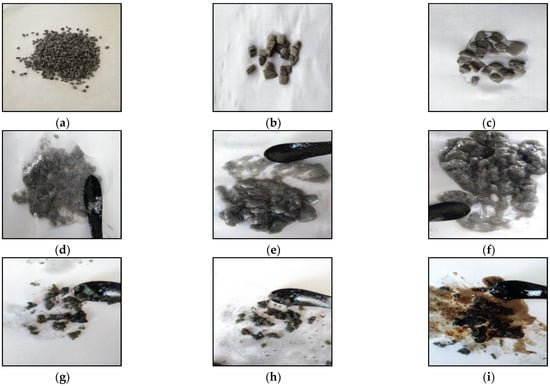
Figure 10.
Morphological diagram of particles before and after immersion in different environments. (a) Unsaturated water swelling rubber particles, (b) After immersion in clean water for 90 days, (c) After sewage soaking for 90 days, (d) After soaking in NaOH solution for 90 days, (e) After immersion in NaCO3 solution for 90 days, (f) After soaking in NaHCO3 solution for 90 days, (g) After diesel oil soaking for 90 days, (h) After soaking in kerosene for 90 days, (i) After 90 days of crude oil immersion.
From the appearance, it can be seen that the water and sewage have less erosion in the water swelling rubber particles, and the particle strength has basically no change after soaking for three months. Under oily conditions, the particles are gradually eroded, and the strength decreases more. Soaking under alkaline conditions has a great impact on the properties of water swelling rubber particles. After soaking, the particles can be rolled gently with a spoon to form flocs. After three months of soaking, the strength of the particles will lose a lot, and the chemical degradation phenomenon is significant. The long-term soaking can achieve complete degradation, fully verifying the degradability of water swelling rubber particles.
- (2)
- Evaluation results of swelling properties of water swelling rubber particles under various environments
The expansion performance of particles in various environments was tested, and the expansion multiple of particles was obtained as shown in Figure 11:
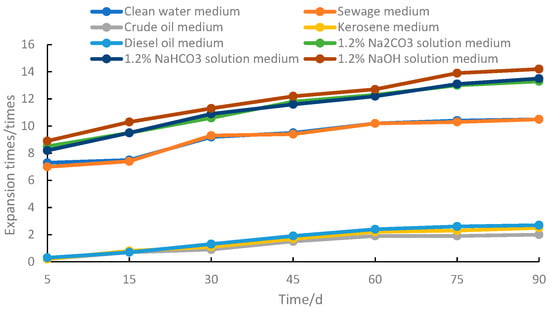
Figure 11.
Comparison of expansion ratios of particles after immersion in various environments.
Through comparison, it can be seen that the expansion times of water swelling rubber particles after long-term immersion in the formation water environment are gradually increasing, and finally the expansion times of both are basically the same, reaching 10.5 times. The expansion ratio of particles after long-term immersion in the formation oil environment has also gradually increased, but the overall expansion ratio is not high, the curve is relatively gentle, and the final expansion ratio remains about 2.5 times. The expansion times of the particles in alkaline environment are the highest. Compared with the performance in 1.2% Na2CO3 solution, 1.2% NaHCO3 solution, and 1.2% NaOH solution, the expansion times of the water expanded rubber particles are 13.3 times, 13.5 times, and 14.2 times, respectively.
Compared with alkaline environment and formation water environment, the expansion ratio of water swelling rubber particles in the formation oil environment is very low, which ensures that they will not expand too much to block the throat in areas with high oil saturation, affecting the recovery of remaining oil. At the same time, in areas with more water, they can maintain a high expansion ratio to effectively block large channels, which is characterized by water plugging without oil plugging, and has strong selective plugging ability.
- (3)
- Evaluation results of compressive strength of water swelling rubber particles under various environments
The compressive strength of water swelling rubber particles was tested after immersion in various environments to determine the stability of the particles. The through-hole strength is shown in Table 9:

Table 9.
Comparison of via strength of particles after immersion in various environments.
Through comparison, it can be seen that the pore strength of water swelling rubber particles after long-term immersion in clean water and sewage environment is similar, and both remain at about 3 MPa. The pore strength of particles immersed in formation oil environment for a long time is much lower than that in clean water and sewage environment, about 1.5 MPa. In alkaline environment, the loss of particle strength is the largest, and the pore strength of particles after long-term immersion is only about 1.0 MPa.
Because the lower the compressive strength, the more easily the particles are deformed and broken. First of all, in the formation water environment, the compressive strength of water-swellable rubber is much higher than that after immersion in the formation oil environment, indicating that the particles can quickly pass through the area with higher oil saturation and enter the area with higher water content; and in the alkaline environment The lower compressive strength proves the degradability, so the water-swellable rubber particles in the formation can be slowly degraded over time by injecting alkaline solutions such as surfactants in subsequent operations.
To sum up, water swelling rubber particles not only have good effects on expansion performance and compressive strength, but can also selectively block high permeability areas in different fluid environments, and can be degraded slowly in alkaline environments, meeting the requirements of reservoir redevelopment.
3.3. Study on Plugging Performance of Water Swelling Rubber Particles to Cracks
- (1)
- Effect of swelling of water swelling rubber particles on plugging performance
According to the experimental scheme in Section 2.5, the resistance coefficient and residual resistance coefficient of water swelling rubber particles that have not expanded and have expanded for 30 days under different overburden rock pressures are as shown in Table 10:

Table 10.
Particle Drag Coefficient Data Sheet.
The residual resistance coefficients of water swelling rubber particles with different particle sizes under different overburden rock pressures are shown in Table 11:

Table 11.
Particle Residual Drag Coefficient Data Sheet.
It can be seen that the residual resistance coefficient of unexpanded rubber particles with different particle sizes is slightly larger than the residual resistance coefficient of the particles after expansion for 30 days; the residual resistance coefficient of unexpanded water-swelled rubber particles is slightly larger than the resistance coefficient; the residual resistance coefficient of the expanded particles is lower. Because the water-swellable rubber particles in the early stage of preparation have swelling characteristics in the core pores, they can enter the high permeability area for plugging. The particles that have expanded for 30 days have expanded to a larger volume, and their continued expansion performance in the core pores is poor, so it is not easy to migrate into the high permeability area, and the residual resistance coefficient is low. Under the same conditions of particle size and expansion time, the particle resistance coefficient and residual resistance coefficient increase with the increase of overlying core pressure.
It can be seen from the comparison that the residual resistance coefficient of water swelling rubber particles with the particle size of 0.150–0.250 mm will increase with the increase of the overburden rock pressure. Until the overburden rock pressure rises from 12 MPa to 14 MPa, the residual resistance coefficient will decrease. The residual resistance coefficient of particles with grain size of 0.250–0.420 mm will increase with the increase of overlying rock pressure, but it will slowly increase when the overlying rock pressure rises from 10 MPa to 12 MPa, and the residual resistance coefficient will decrease when the overlying rock pressure rises from 12 MPa to 14 MPa. Similarly, the residual resistance coefficient of particles with a grain size of 0.420–0.840 mm also follows this rule, and the residual resistance coefficient will drop significantly when the pressure of the overlying rock rises from 10 MPa to 12 MPa, indicating that with the decrease of the crack width, the plugging effect of particles will be better. When the crack width is small to a certain extent, particles with too large grain size may accumulate at the injection end of the core, resulting in failure to inject into the core without plugging effect. Therefore, it is necessary to further study the relationship between particle size and overlying rock pressure.
- (2)
- Evaluation results of plugging performance of water swelling rubber particles for large, fractured channels
According to the experimental scheme in Section 2.5, the plugging capacity of the water swelling rubber particle plugging agent system for fractures under different overburden rock pressures is measured as shown in Table 12.

Table 12.
Plugging performance of water-swellable rubber particles under different overburden pressures.
It can be seen from Table 12 that the plugging of water swelling rubber particles on fractures under different overburden rock pressures is obviously different. Before the particles are injected, the water drive pressure will gradually increase with the increase of the overlying rock pressure, indicating that the seepage capacity of the fracture itself will become poor with the increase of the overlying rock pressure. When water swelling rubber particles are injected, the breakthrough pressure increases significantly. The breakthrough pressure after particle injection can reach 1.15 MPa, while the maximum pressure of the overlying core is 14 MPa, and the water drive pressure is only 0.12 MPa, but the breakthrough pressure after plugging can reach 11.76 MPa. After the particles are injected, the overall breakthrough pressure is kept at a high level, and the plugging rate is greater than 90%, meeting the plugging demand.
However, in the subsequent water drive process, the stable pressure of water drive under different overburden rock pressures drops rapidly, which indicates that the water swelling particles are easy to be carried out of the fractures under the subsequent water scouring during the process of plugging the fractures, leading to the reduction of the effective period of plugging.
- (3)
- Evaluation Results of Erosion Resistance and Matching Relationship of Water Expanding Rubber Particles to Large Crack Pores
Due to the large size of the crack, the retention capacity of water swelling rubber particles in the crack will seriously affect the plugging effect. In order to analyze the retention effect of water swelling particles in the crack, according to the experimental scheme in Section 2.5, the characteristics of the crack interior and the produced liquid are observed through a microscope, as shown in Figure 12:
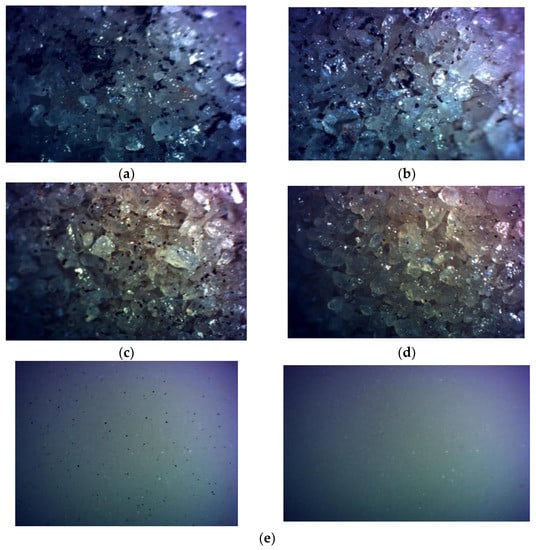
Figure 12.
Fracture interior and produced fluid characteristics. (a) Injection end (before flushing), (b) Outlet end (before scouring), (c) Injection end (after flushing), (d) Outlet end (after scouring), (e) Solid suspension in produced liquid.
It can be seen from Figure 12 that there are many particles in the non-scoured fractures both at the entrance and the extraction end of the fractures, which indicates that the system has strong injection capacity. However, through the core plugging experiment, it is preliminarily found that there are a large number of particles in the washed core produced fluid, which are easy to break through under the subsequent flushing of the injected water, and the particles cannot be retained in the core but migrate with the injected fluid. Hence, blocking performance is affected.
In order to quantitatively analyze the influence of subsequent fluid scouring on the plugging effect of water swelling rubber particles, the final plugging rate results of water swelling rubber particles with different particle sizes under different overburden rock pressures are shown in Table 13:

Table 13.
Final plugging rates of water-swellable particles of different sizes under different overlying rock pressures.
From Table 13, it can be seen that the plugging rate of water swelling rubber particles of all sizes under different rock overburden pressures is basically more than 90%, and the plugging rate will increase with the increase of overburden rock pressure, indicating that water swelling rubber particles have good plugging performance for large, fractured channels.
When the overlying pressure is 14 MPa, the plugging rate of particles with grain size of 0.420~0.840 mm is only 53.92%, while the plugging rate of particles with grain size of 0.250~0.420 mm is higher, but it is still the lowest among particles with grain size of 0.150~0.250 mm. The reason is that when the water swelling rubber particles are too large, they cannot enter the cracks with small size, and the particles accumulate at the injection end, which cannot play the role of plugging, resulting in a low plugging rate.
By comparing the plugging rate before and after scouring under different overburden rock pressures, it can be seen that the plugging performance of water swelling rubber particles with all particle sizes has decreased after scouring by injected water, especially for particles with smaller particle sizes, this scouring effect will be more obvious.
To sum up, for the plugging of fractured large channels, when the overburden core pressure is high, the fracture is narrow, and the permeability is low, the non-nuclear water swelling rubber particles with a particle size of 0.150~0.250 mm can be used for plugging, and the particle size has strong applicability. For particles with a particle size of 0.250–0.420 mm, although the plugging performance is slightly weaker in areas with low permeability than that of the previous particles, the plugging performance is better for most areas. The particle size of 0.420~0.840 mm is not conducive to plugging the area with low permeability, so the particle size is not selected for injection. Therefore, for the treatment of large, fractured channels, particles with a particle size of 0.250–0.420 mm can be injected first to block the areas with high permeability, and then particles with a particle size of 0.150–0.250 mm can be injected to block the areas with low permeability.
At the same time, after the core is washed, the particle content is less and the plugging rate decreases, which indicates that for the treatment of fractured pores, the retention capacity of water swelling rubber particles in the fractures needs to be further enhanced to avoid the migration of particles with the subsequent injection fluid, so as to achieve the purpose of stable plugging.
4. Conclusions
- (1)
- A new type of water-swellable rubber particles were synthesized, modified, and sorted in the laboratory. The particle density is moderate and suitable for deep profile control. The viscosity and surface tension of the polymer have a low effect, and the performance of the polymer solution will not be affected when mixed and injected. The expansion ratio of the particles in both sewage and clean water environments can reach about seven times, and after expansion, it can still maintain 3.0 through a 3 mm orifice plate. The through-hole strength of MPa proves that the particles have certain strength and deformation properties, can enter the deep formation to block high-permeability areas, and still have good strength at a high temperature of 90 °C.
- (2)
- After soaking in the formation water environment, the expansion ratio of water-swellable rubber particles reaches about 10.5 times, and after soaking in the alkaline environment, the expansion ratio reaches about 13–14 times. Compared with the alkaline environment and the formation water environment, the expansion ratio of particles in the formation oil environment is very low, and the final expansion ratio is about 2.5 times, so it will not expand too much in areas with high oil saturation, and it is effective to maintain a higher expansion ratio in areas with more water content Block large pores. After long-term immersion in an alkaline environment, the strength of the particles decreases significantly, by only 1.0 MPa, so in an alkaline environment, they can be gradually broken over time to achieve the effect of blocking removal.
- (3)
- It can be seen from the laboratory simulation experiments that under the same conditions of particle size and expansion time, the particle resistance coefficient and residual resistance coefficient will increase with the increase of the overlying core pressure. The residual resistance coefficient of water-swellable rubber particles of different particle sizes will increase with the increase of the overlying rock pressure under different overlying pressures, but when the pressure increases to a certain extent, the residual resistance coefficient will decrease, indicating that the excessive particle size is too large. The particles of different particle sizes will accumulate at the injection end of the core, so that the particles cannot be injected into the experimental core, and the corresponding plugging effect cannot be achieved. The plugging rates of particles of different particle sizes under different rock overburden pressures basically shows a pattern from high to low. The plugging rate gradually increases with the increase of the overlying core pressure, but when the overlying core pressure reaches a certain level, the plugging rate shows a downward trend, which further proves that too large particles cannot be injected into too narrow fractures. Therefore, for the treatment of large, cracked pores, the particle size range of water-swelling rubber that matches the crack width should be selected. The two kinds of particles have better adaptability to channels with different crack widths.
Author Contributions
Conceptualization, T.L. and D.L.; methodology, T.L.; software, P.X.; validation, T.L., D.L. and P.X; formal analysis, Y.L. and W.Y.; investigation, X.Z.; resources, G.C.; data curation, X.B.; writing—original draft preparation, T.L.; writing—review and editing, T.L.; visualization, D.L.; supervision, G.C.; project administration, X.B.; funding acquisition, G.C. All authors have read and agreed to the published version of the manuscript.
Funding
This research received no external funding.
Institutional Review Board Statement
Not applicable.
Informed Consent Statement
Not applicable.
Data Availability Statement
Not applicable.
Conflicts of Interest
The authors declare no conflict of interest.
References
- Cui, C.; Li, K.; Yang, Y.; Huang, Y.; Cao, Q. Identification and quantitative description of large pore path in unconsolidated sandstone reservoir during the ultra-high water-cut stage. J. Pet. Sci. Eng. 2014, 122, 10–17. [Google Scholar]
- Zhang, L.; Pu, C.; Yang, J.; Chen, Q.; Sang, H.; Zhao, Q. Application of graft copolymer of ultra-fine cellulose and acrylamide in profile control and water plugging. Oilfield Chem. 2015, 32, 503–506. [Google Scholar]
- Lu, Y.; Li, X.; Ren, X. A new shear resistant modified weak gel profile control system. Petrochem. Ind. 2018, 47, 605–610. [Google Scholar]
- Zhang, M.; Wu, J.; Shi, F. Preparation and performance evaluation of HPAM/Cr3+ weak gel system for deep profile control and flooding. Chem. Eng. 2019, 33, 9–12. [Google Scholar]
- Sun, N. Research on Weak gel Profile Control and Flooding Technology after Binary Composite Flooding in JZ9-3 Oilfield; Northeast Petroleum University: Daqing, China, 2018. [Google Scholar]
- Snoeck, D.; Jensen, O.M.; Belie, N.D. The influence of superabsorbent polymers on the autogenous shrinkage properties of cement pastes with supplementary cementitious materials. Cem. Concr. Res. 2015, 74, 59–67. [Google Scholar] [CrossRef]
- Liu, J.; Lu, X.; Zhang, Y. Effect of surfactant and alkali on gelling effect of Cr3+ polyacrylamide gel and its mechanism. J. Acta Pet. Sin. (Petroleum Processing Section). 2018, 34, 614–622. [Google Scholar]
- Xiao, Y.; Tao, Y.; Zhuhua, Z. Fly Ash-based Geopolymers: Effect of Slag Addition on Efflorescence. J. Wuhan Univ. Technol. (Mater. Sci.) 2016, 31, 689–694. [Google Scholar]
- Naghizadeh, A.; Ekolu, S.O. Method for comprehensive mix design of fly ash geopolymer mortars. Constr. Build. Mater. 2019, 202, 704–717. [Google Scholar] [CrossRef]
- Wang, X.; Qi, Y.; Peng, R.; Wang, F.; Tian, F.; Xiao, J.; Li, T.; Yu, J.; Chen, J.; Xu, W. Development status and future development trend of China’s nitrile rubber industry. Polym. Bull. 2016, 4, 1–16. [Google Scholar]
- Liu, X.; Shang, H. Evaluation of dynamic gelling performance of gel profile control agent in deep formation. Daqing Pet. Geol. Dev. 2020, 39, 86–90. [Google Scholar]
- Assi, L.N.; Deaver, E.; ElBatanouny, M.K.; Ziehl, P. Investigation of early compressive strength of fly ash-based geopolymer concrete. Constr. Build. Mater. 2016, 112, 807–815. [Google Scholar] [CrossRef]
- Sui, Y.; Cao, G.; Guo, T.; Li, Z.; Bai, Y.; Li, D.; Zhang, Z. Development of gelled acid system in high-temperature carbonate reservoirs. J. Pet. Sci. Eng. 2022, 216, 110836. [Google Scholar] [CrossRef]
- Simonin, L.; Boukaftane CDecker, C. Study of water sorption in rubbers by acoustic microscopy. Polym. Int. 2015, 49, 585–590. [Google Scholar] [CrossRef]
- Dehbari, N.; Tang, Y. Water swellable rubber composites: An update review from preparation to properties. J. Appl. Polym. Sci. 2015, 132, 42786–42797. [Google Scholar] [CrossRef]
- Zhang, Z.; Zhang, G.; Wang, C.; Liu, D.; Liu, Z.; Chen, X. Chlorohydrin water-swellable rubber compatibilized by an amphiphilic graft copolymer. III. Effects of PEG and PSA on water-swelling behavior. J. Appl. Polym. Sci. 2015, 79, 2509–2516. [Google Scholar] [CrossRef]
- Wang, B.; Liao, S.; Li, C. Bentonite/acrylamide graft-modified natural rubber to prepare water-swellable rubber. Chin. J. Mater. Sci. Eng. 2015, 33, 415–419. [Google Scholar] [CrossRef]
- Zhou, X.; Chen, J.; Wang, J.; Zhang, X.; Li, Z. Preparation and properties of water-swellable rubber resistant to ultra-high salinity. Elastomers 2018, 28, 1–5. [Google Scholar]
Publisher’s Note: MDPI stays neutral with regard to jurisdictional claims in published maps and institutional affiliations. |
© 2022 by the authors. Licensee MDPI, Basel, Switzerland. This article is an open access article distributed under the terms and conditions of the Creative Commons Attribution (CC BY) license (https://creativecommons.org/licenses/by/4.0/).